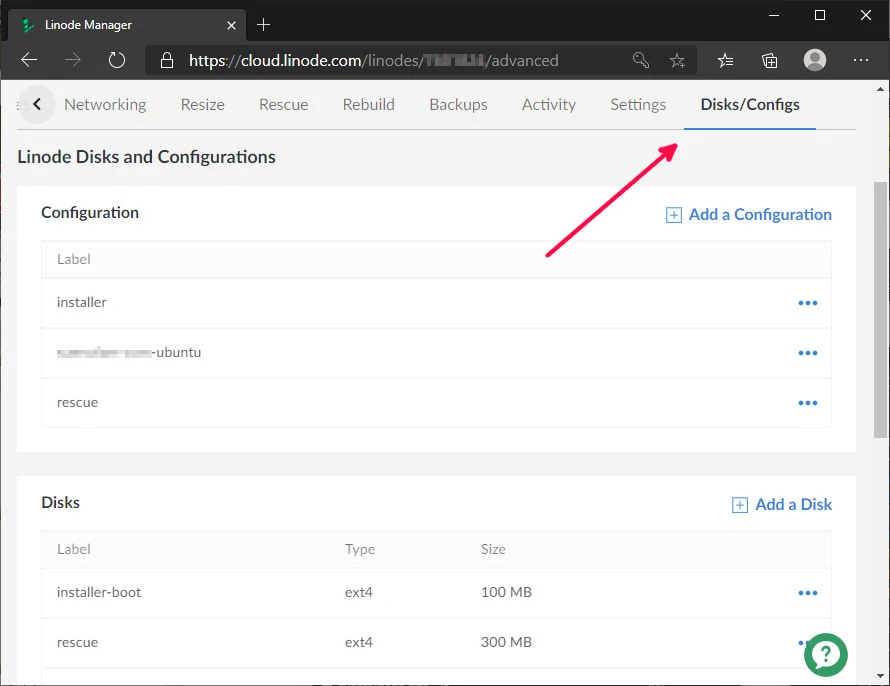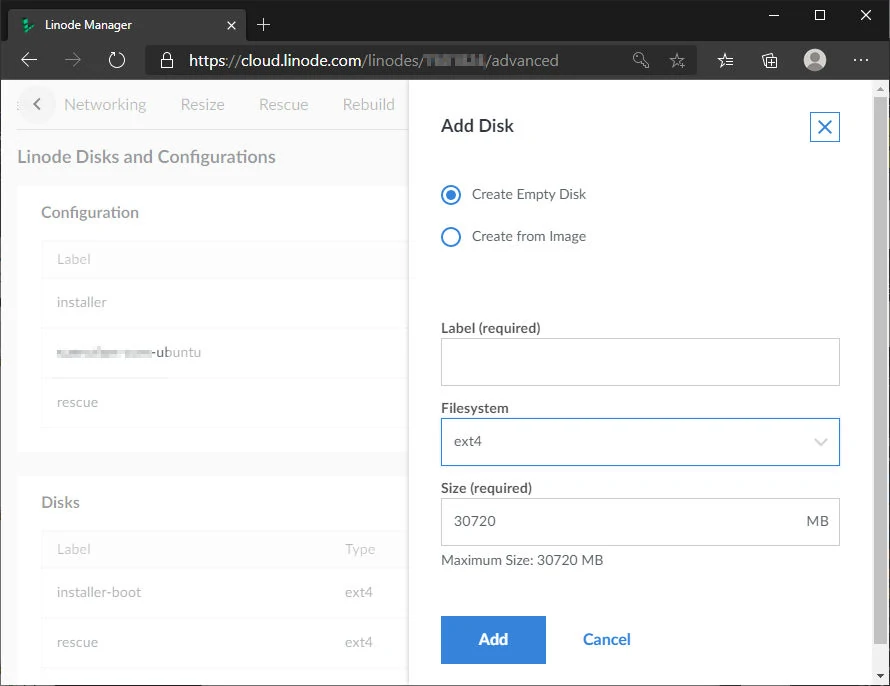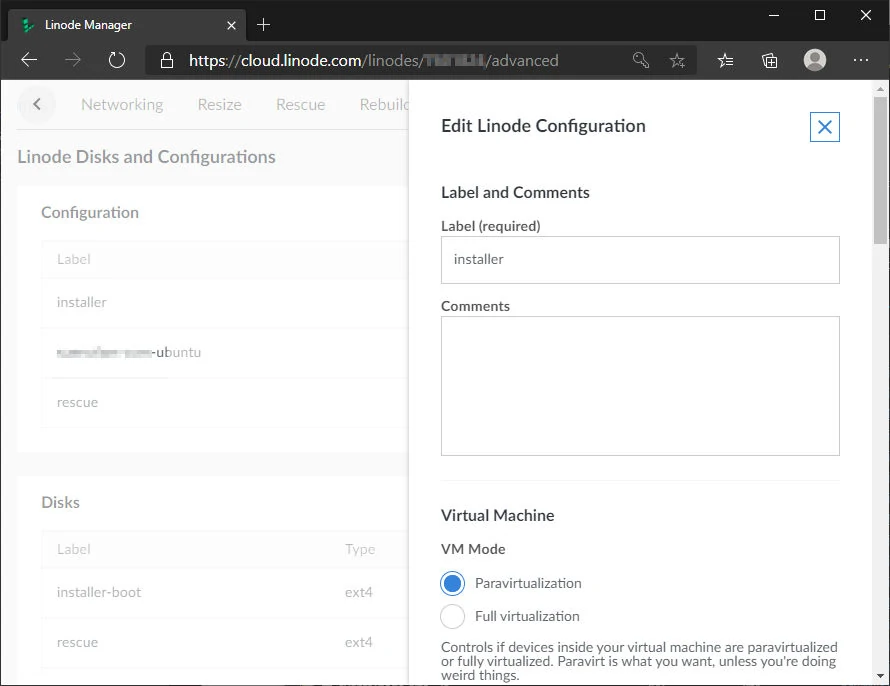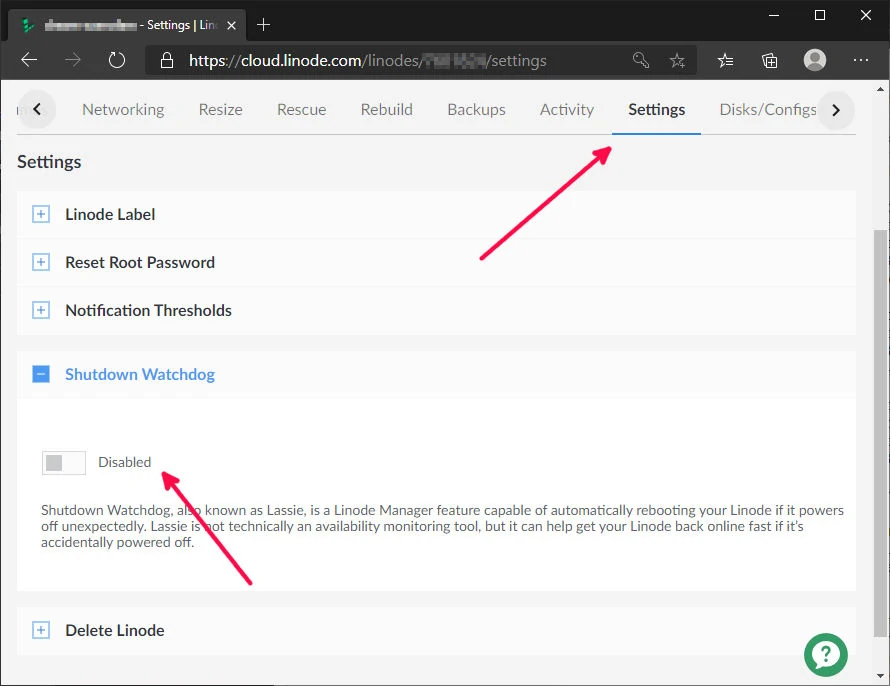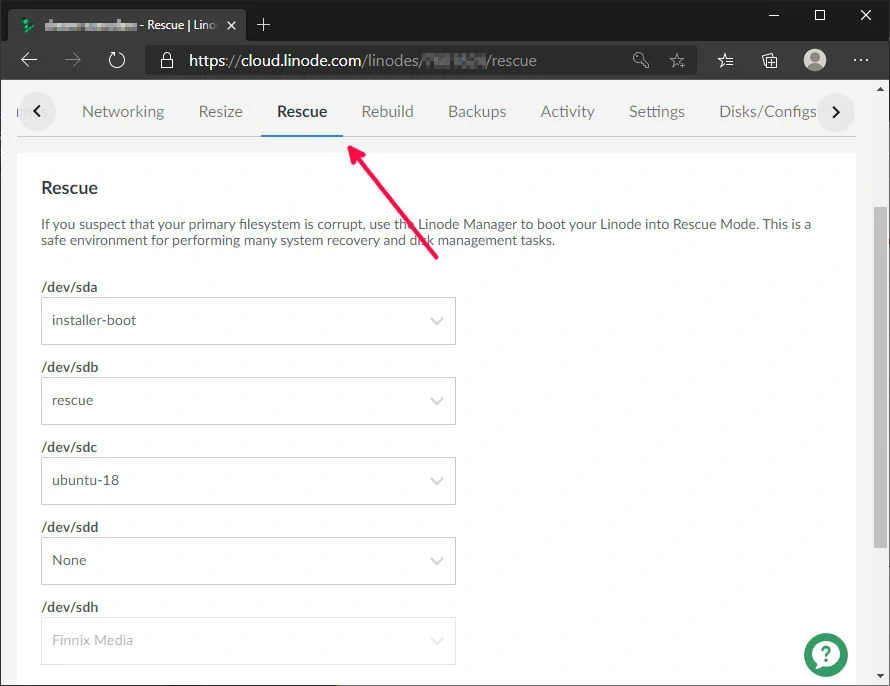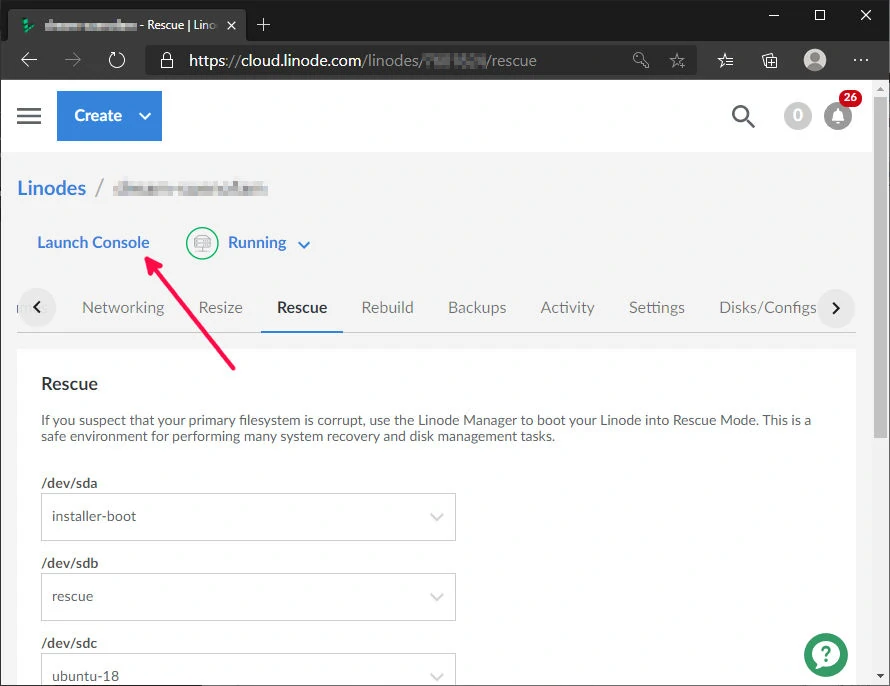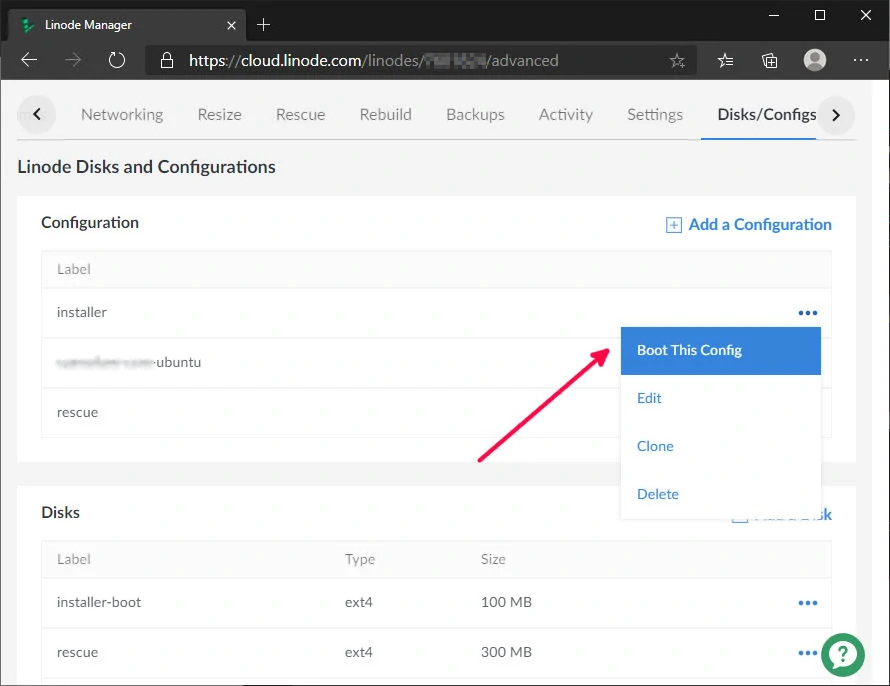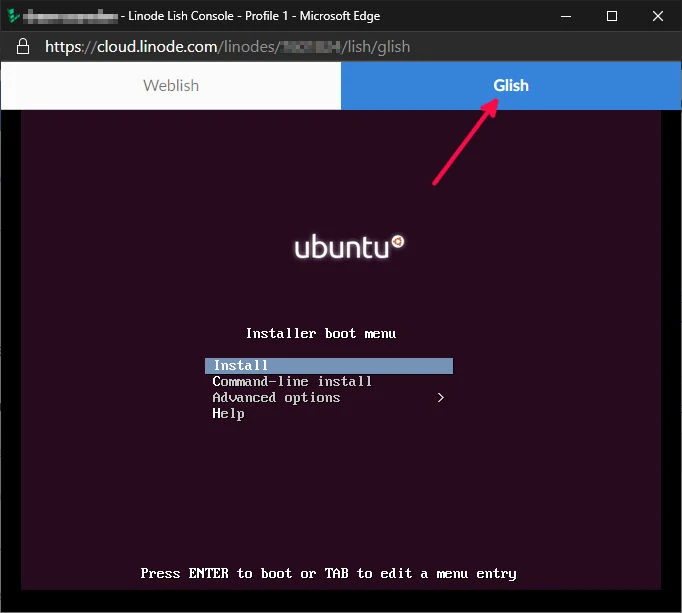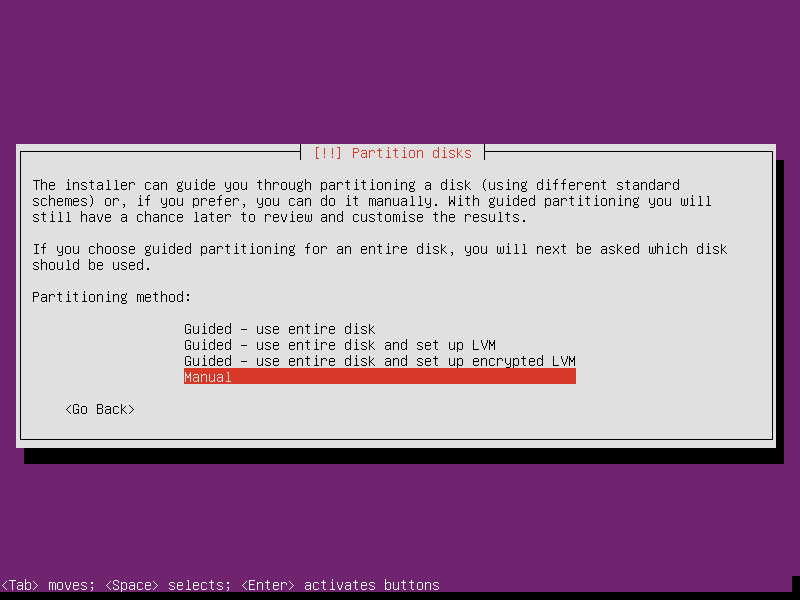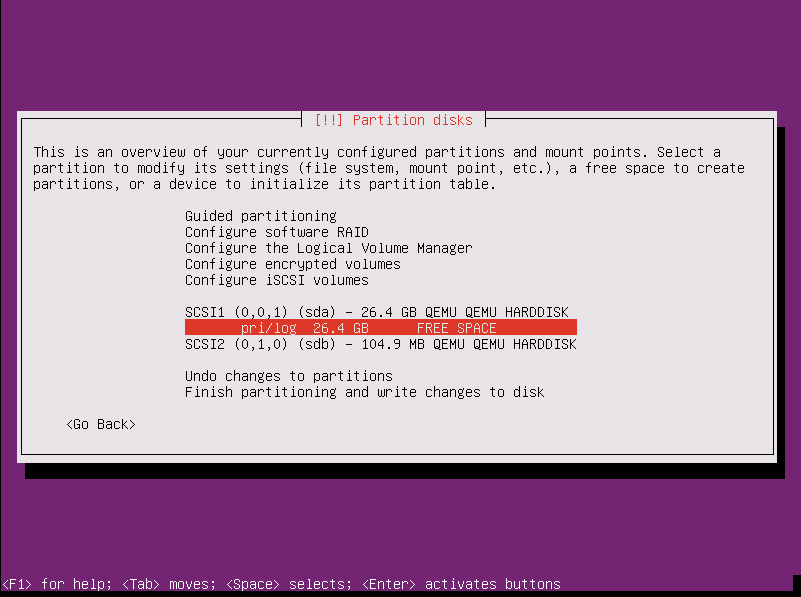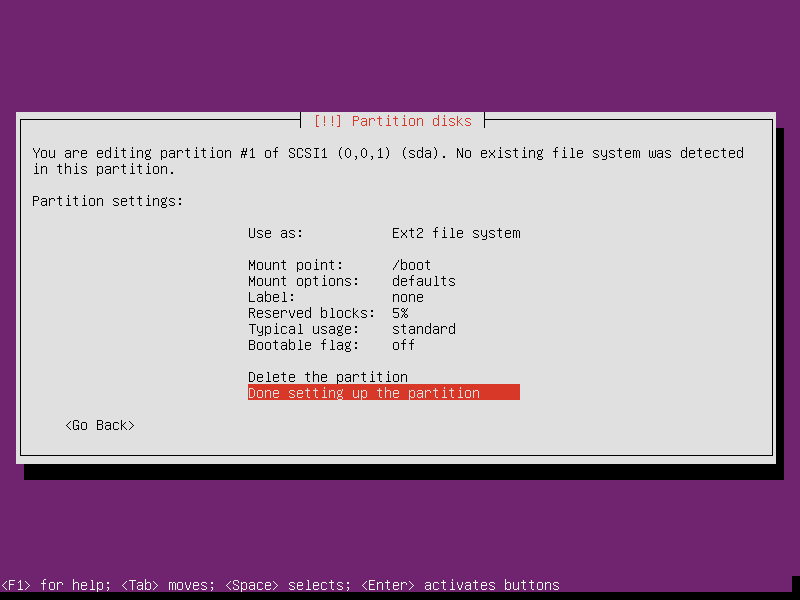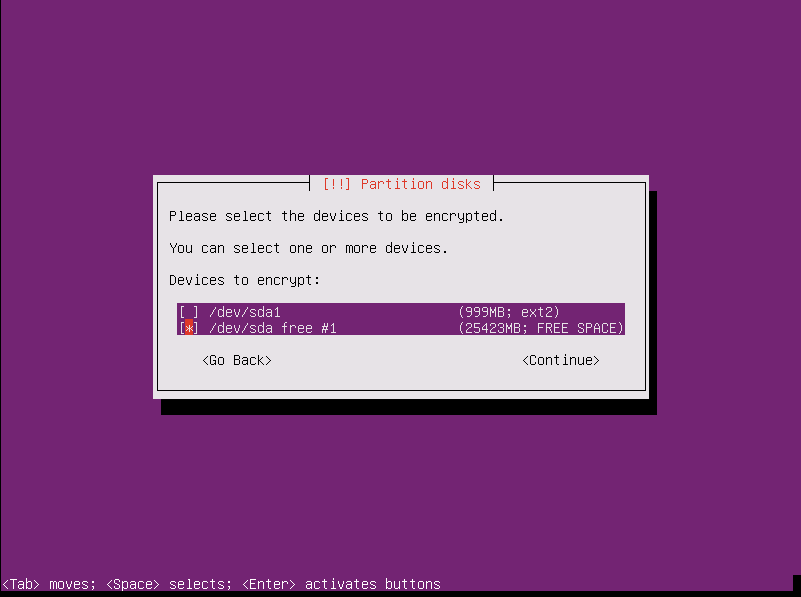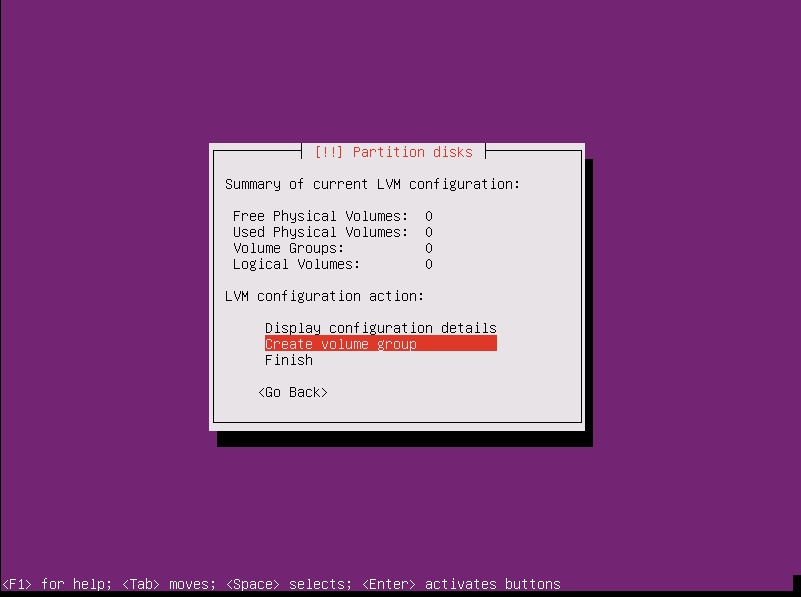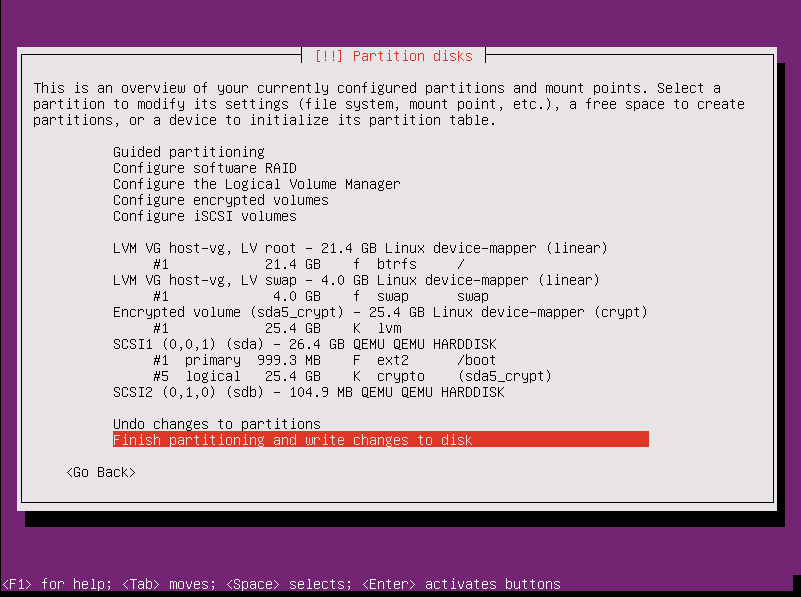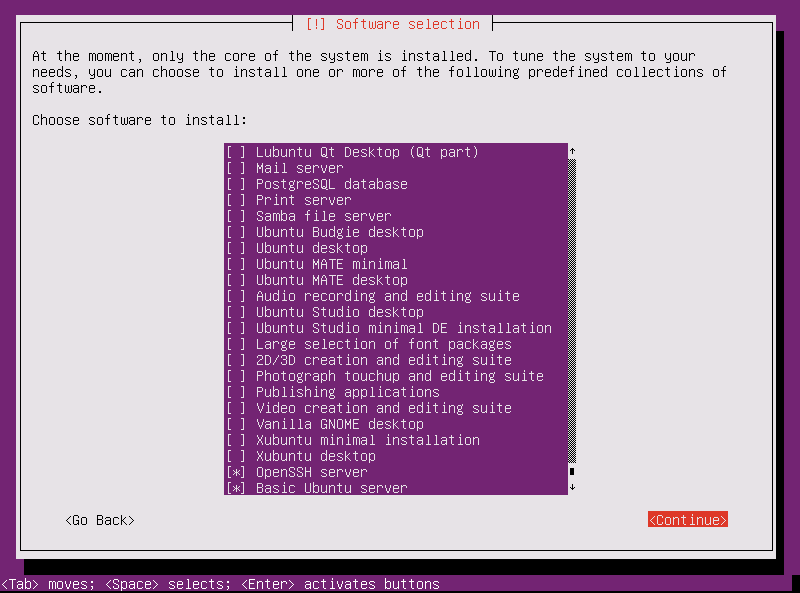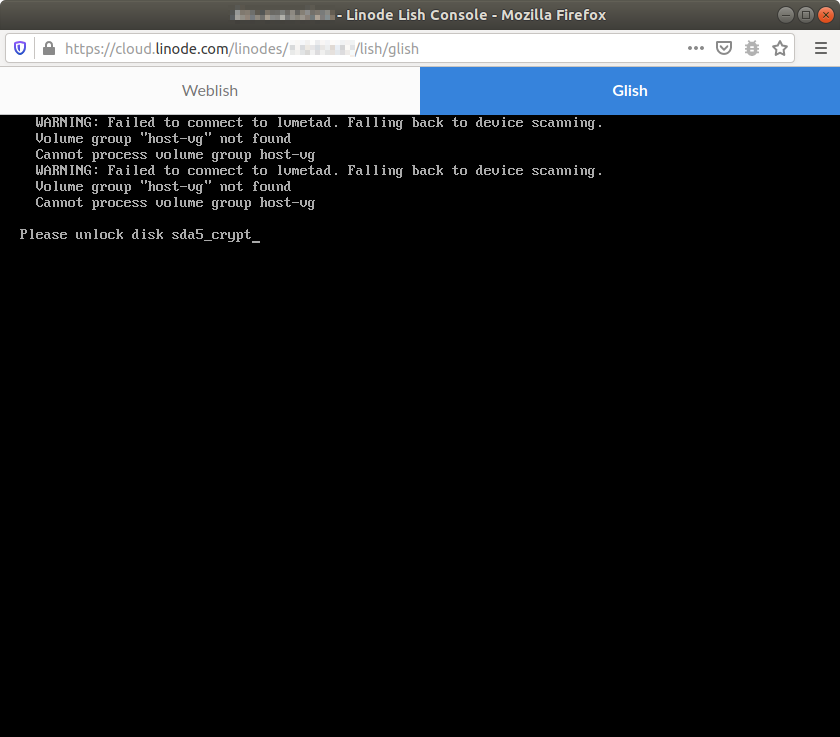Ubuntu 20.04 Full Disk Encryption (LUKS) on the Cloud
Author: Paul Sueno
Created: 5/27/2020 // Updated: 2/14/2021
Set up a LUKS encrypted Ubuntu server on the cloud. This is for 20.04 LTS. I chose Ubuntu due to regular updates & strong peer support.
Ubuntu released Focal Fossa (20.04 LTS) in April 2020. This tutorial will set up a LUKS encrypted Ubuntu server on the cloud. Ubuntu is a flavor or distribution of Linux, one of the most widely used open source operating systems out there. It is updated regularly, and many people use it around the world.
The server has to be accessible 24/7 with little risk of down-time. Another requirement is that the whole system has to be encrypted to protect the data from snooping. Canonical threw in a curve ball for this LTS release, and more on this below. All these factors together, I will show you how to install Ubuntu 20.04 LTS as a Linode cloud service.
If you would rather install Ubuntu 18.04 LTS (Bionic Beaver) click here.
Ubuntu and Linode Disclaimer: Ubuntu and the Ubuntu logo are registered trademarks of Canonical Ltd. Linode and the Linode logo are registered trademarks of Linode LLC. This blog references these trademarks as commentary. I am in no way speaking for or on behalf of Canonical or Linode, and I do not imply endorsement by Canonical or Linode.
Cloud or on-site server
Cloud based web services seems like a costly endeavor, but as low as $5 per month it beats paying $2k (or more) up front for a physical server. Another bonus is cloud services generally are on the web all the time. If you set up your server from home, think how many times your internet went down or had to reset the router.
My tutorials will be based on the cloud service I use, Linode. They have a server in my part of the USA, and had all the features I required. But you are more than welcome to use whatever cloud service you want. Others include DigitalOcean, Vultr, Azure, AWS, etc.
Creating a Linode
I started my server with a Linode Nanode at just $5 per month. Since starting out with a Nanode, my server needs have grown larger. Feel free to start there and upgrade if needed. I had to do this, and it wasn't too bad.
Because the operating system will be installed with encryption, the default set ups were inadequate. No worries, I'll walk you through a custom install.
After purchasing your linode, click on it to load up the dashboard. On the menu bar, go all the way to the right and select the "Disks/Configs" tab.
Linode - add disk & boot configs
Firstly, set up the hard drives/disks:
- Installer disk, will have Ubuntu netboot install image loaded
- Rescue disk, will have a rescue boot or live CD/DVD image loaded
- Main system disk, will be the main server disk
Click on Add a Disk under the Disks section (see image above). You should create three Disks, one for each of the above. Be sure to select Create Empty Disk for each one. Each one will require a label, filesystem and size. We will set up the partitions for the different boot configurations later on.
Canonical has done something odd starting with Ubuntu 20.04 LTS. They have hidden from official documentation the mini.iso installation method. They want installation to occur by net install or by cloud image methods. These will not work for our system. It is too difficult to find a cloud service provider that allows PXE net install. I also don't know of a cloud image install method that allows system-wide encryption. Fortunately, Canonical did create a mini.iso for Focal Fossa. It required some hunting to find.
For the installer, I based the size on how big the "netboot" or network installer for Ubuntu 20.04 LTS (Focal Fossa). This is the smallest installer, and it will download all the necessary packages after the installer boots up. This is what we want; we don't want to waste precious cloud storage space on GB of installer software we will rarely (if ever) use again. You'll see that the mini.iso (the file we'll download later) is 74MB (as of writing this blog). I rounded up and chose 100 MB for the installer disk.
For the rescue disk, I made my own Debian flavor rescue ISO that was about 200MB. The most popular pre-built live or rescue Linux flavor is Knoppix. The CD iso is about 701 MB. You can skip this part all together if you don't think you need a rescue disk, and rely on Linode's own rescue software. I didn't like their limited packages available, and was not too familiar with Finnix, which is what they use.
The rest of the cloud disk space can be allocated to your main system disk. Below are my settings for each disk. You should modify them to meet your needs.
Installer Disk:
- Create Empty Disk
- Label: installer
- Filesystem: ext4
- Size: 100 MB
Rescue Disk:
- Create Empty Disk
- Label: rescue
- Filesystem: ext4
- Size: 300 MB (yours may be 700+ MB if you use Knoppix CD or whatever)
System Disk:
- Create Empty Disk
- Label: ubuntu
- Filesystem: raw (this is important!)
- Size: use the rest available
Now it's time to set up the boot configurations. Click on Add a Configuration under the Configuration section. With each configuration, we have to decide which disks should be available and which one to boot from. Similar to the disks, I have three separate boot configurations. One each for installer, rescue and system (Ubuntu) boot configurations. When assigning the disks, we tell the configuration how to reference them via the standard Linux method, e.g., /dev/sda, /dev/sdb and /dev/sdc. Here are the settings for each configuration.
Installer Configuration:
- Label: installer
- VM Mode: Paravirtualization
- Select a Kernel: Direct Disk
- Run Level: Run Default Level
- Memory Limit: Do not set any limits on memory usage
- Block Device Assignment
- /dev/sda: ubuntu (disk)
- /dev/sdb: installer (disk)
- Use Custom Root: off
- Root Device: /dev/sdb
- Filesystem/Boot Helpers: all off
Rescue Configuration:
- Label: rescue
- VM Mode, Kernel, Run Level and Memory: same as above
- Block Device Assignment
- /dev/sda: ubuntu (disk)
- /dev/sdb: rescue (disk)
- /dev/sdc: installer (disk)
- Use Custom Root: off
- Root Device: /dev/sdb
- Filesystem/Boot Helpers: all off
Ubuntu (system) Configuration:
- Label: ubuntu
- VM Mode, Kernel, Run Level and Memory: same as above
- Block Device Assignment
- /dev/sda: ubuntu (disk)
- Use Custom Root: off
- Root Device: /dev/sda
- Filesystem/Boot Helpers: all off
Linode - other settings
Because we are installing our own custom Ubuntu system, the built-in Linode tools may break our system. On the main dashboard, click on "Settings" tab. There, expancd Shutdown Watchdog and make sure it is Disabled.
Download Ubuntu and rescue ISO
I know we set up our three boot configurations already. But to get the Ubuntu netboot installer and custom (or Knoppix or other) rescue ISO downloaded, we have to load a one-time "rescue". This is different than the rescue above. Sorry about the naming confusion. Click on "Rescue" tab from the Dashboard.
Set up the following block device assignments:
- /dev/sda: installer
- /dev/sdb: rescue
- /dev/sdc: ubuntu (optional)
Click "Reboot into Rescue Mode". After Rescue Mode boots, be sure it says Running above the menu tabs. Then click on "Launch Console" right beside where it says Running. This will load a pop-up that gives us access to the disks we selected above for this one-time rescue boot. We will stay in the Weblish tab.
In the Weblish console, you should see some basic boot status lines and a Welcome to Finnix! line. We are now using Linux, woo hoo!! If you want to confirm you have the right disks assigned, type in lsblk at the root # prompt.
For the rescue ISO, I saved the file onto a webserver I already had set up. You can either download the Knoppix ftp link directly, or use your own. Let me explain the four lines below. The first line downloads the Ubuntu netboot installer as an ISO file. The second line takes the image of the ISO file as the if= (or in file) and clones it to an out file as the actual files. The of= or out file is the installer device block we assigned to /dev/sda.
In other words, we download the installer ISO. The files stored in the installer ISO will then be copied to the installer disk in a bootable format.
A similar process is done for the rescue ISO and disk. Be sure to replace appropriate text inside the square brackets [ ]. Type in the following lines in the command line.
wget http://archive.ubuntu.com/ubuntu/dists/focal/main/installer-amd64/current/legacy-images/netboot/mini.iso
dd if=mini.iso of=/dev/sda
wget http://[Knoppix or your own hyperlink to rescue ISO]
dd if=[rescue ISO file] of=/dev/sdbInstall Ubuntu 20 (Focal)
Now we're ready to install Ubuntu. Go back to the Linode dashboard, and click "Disks/Configs" tab. Under the Configuration section, click on the three-dots ... to the right of installer. Then click "Boot this Config".
Be sure the installer configuration has finished booting and has a status of "Running". Now click on "Launch Console" as above. With the pop-up window, click on Glish to start the Ubuntu install. Click on the install screen window, and press Enter to select and proceed with Install.
The first few screens will guide you through the keyboard. I use the default recommendations (standard English US), and probably what you want as well. The installer will then make sure the internet is available and start downloading a few packages.
Next up enter a hostname. This is what your server will be known in your network (even if it's just a network of 1 server). But if you have a domain registered, you can tie this server with that domain and identify the server with the hostname. This can be changed later on. The next screens help the installer find the closest Ubuntu mirrors to download the packages from. The defaults are fine, if you're in the USA. Unless you know you are behind a proxy, leave the HTTP proxy information blank. More packages will be downloaded. Then the installer gets information about you: name, username and password. The installer guesses where your timezone is. Change it if needed, but be sure it is set up in the timezone you want. Next up are steps to encrypt the whole system.
Encrypt - LVM - partition disks
You should be at the screen asking you to [!!] Partition disks. This is where all the magic is done to set up whole-system LUKS encryption (which is based on dm-crypt). We will be encrypting the main system device block, and under that layer of encryption will set up logical volum management (LVM) file systems.
This tutorial will guide you through the Manual set up of encryption, LVM and file system partitioning. I had to do this for setting up minimum requirements for one of the programs I wanted running. If you want to just start out with a basic system encrypted Ubuntu server, feel free to select Guided - use entire disk and set up encrypted LVM. You can join back on the tutorial at the appropriate step. For the rest, go ahead and arrow down to Manual and press Enter.
If you set up the device block settings correctly, then SCSI1 or sda should be the system (Ubuntu) disk. You can verify because it is much bigger than SCSI2 or sdb. Select SCSI1 (device block with the largest size), and hit enter. Select Yes to confirm creating a new empty partition table. Now select pri/log [size] FREE SPACE just under the SCSI line selected above. You'll move onto the next screen.
Create boot partition first.
- Select
Create a new partition - New partition size: 1GB
- Type: Primary
- Location: Beginning
- Use as: Ext4 journaling file system
- Mount point: /boot
- OK to leave all other options as is
- Select
Done setting up the partition
Create encrypted volume.
- Move arrow up and select
Configure encrypted volumes - Write changes and configure encrypted volumes? Yes
- Select
Create encrypted volumes - Move arrow down to
/dev/sda free #1(make sure this is largest available) - Press spacebar and enter to select
- OK to use default LUKS settings
- Select
Done setting up the partition - Write changes and configure encrypted volumes? Yes
- Select
Finish - Enter your
Encryption passphrase. WRITE THIS DOWN AND SAVE IT SOMEWHERE SAFE!
Create LVM volume group and logical volumes
- Move arrow up and select
Configure the Logical Volume Manager - Write changes and configure encrypted volumes? Yes
- Move arrow down and select
Create volume group- Remember the hostname you entered before? Use that here. Replace
hostwith your own. - I entered:
host-vg
- Remember the hostname you entered before? Use that here. Replace
- Select the encrypted partition. It should read
/dev/mapper/sda5_crypt - Select
Create logical volume- Select
host-vg(or whatever volume group name you created above) - Name: root
- Select
- Logical volume size:
- I had to create a swap space that was 4GB. You can create one much smaller (maybe 1GB).
- The size you enter here is the available less 4000MB (or less 1000MB)
- Select
Create logical volume- Select
host-vg(or whatever volume group name you created above) - Name: swap
- Select
- Logical volume size: use the rest of the volume (should match the number above)
- Select
Finish
Set up the logical volume partitions
- Create root
/partition- Move arrow down and select
#1just belowLVM VG host-vg, LV root - Use as: btrfs (you can use any file system you choose, the standard is ext4)
- Mount point:
/ - the root file system - OK to leave all other options as is
- Select
Done setting up the partition
- Move arrow down and select
- Create to swap partition
- Select
#1just belowLVM VG host-vg, LV swap - Use as: swap area
- Select
Done setting up the partition
- Select
- Before finalizing the partition scheme, verify your screen looks like mine.
- Under
SCSI1, there should be/bootand(sda5_crypt)or similar partitions - Under
Encrypted volume (sda5_crypt), it should readlvm - Under each logical volume or
LV, it should read (respectively)btrfs /swap swap
- Under
- Select
Finish partitioning and write changes to disk - Write changes and configure encrypted volumes? Yes
Complete Ubuntu install
I want to update my own system manually. Automatic updates are likely to break my system. And so I picked No automatic updates. To keep a lean machine, I didn't want any bloatware. The only software I installed at this point were OpenSSH server and Basic Ubuntu server (scroll to the bottom of that install screen). Be sure to select Yes when asked about GRUB boot loader. Most importantly, when asked to select Device for boot loader installation: pick /dev/sda. Select Yes when asked about system clock and UTC. Now it's time to shutdown the installer boot configuration and select Continue. Now close the Glish window.
Ubuntu inital boot
Go back to the Linode dashboard. Click on "Disks/Configs" menu tab on the right. Under Configuration, go to the ... to the right of ubuntu. Click on Boot This Config. Once the Linode is "Running", click on Launch Console up top. Click on Glish. You should see the window below (sometimes it renders differently). You may need to hit a few arrows to have the text pop up. Type in the LUKS password you created earlier and wrote down to keep safe. If you forget this password, lose the written down copy and the server is reset; you're pretty much screwed. You have been warned.
For whatever reason, Ubuntu 20.04 LTS (Focal) seems to hang with a flashing cursor while booting up (after unlocking the LUKS encryption). I had to load a TTY terminal manually by pressing Alt+F1. You may not need to do this, but I did.
You can now log in with the user credentials you created earlier. The sudo command allows you root privileges. For most of the file modifications below, I use nano text editor.
The following steps allow us to enter the LUKS password in the Weblish window rather than having to go to Glish. Let's back up and modify the GRUB boot loader by running sudo cp /etc/default/grub /etc/default/grub.bak && sudo nano /etc/default/grub. Modify the following lines:
GRUB_TIMEOUT=1
GRUB_CMDLINE_LINUX_DEFAULT=""
GRUB_CMDLINE_LINUX="console=ttyS0,19200n8"
GRUB_SERIAL_COMMAND="serial --speed=19200 --unit=0 --word=8 --parity=no --stop=1"
GRUB_TERMINAL=serialNow run sudo update-grub. Before restarting to see the prompt on Weblish rather than Glish, we have to set up the network. For wahtever reason, Ubuntu loads the wrong name for the network adapter. Find the enp name of the network adapter by running dmesg | grep eth0. Now we modify the netplan configuration file, which tells Ubuntu which network adapter has internet access.
sudo nano /etc/netplan/01-netcfg.yamlChange the network adapter name to the one we found in the dmesg command above. For example, mine was enp0s3. To save Ctrl-o, to exit Ctrl-x. Now restart the settings by running sudo netplan apply. Test it out by running ping bing.com.
Let's also update the apt repositories.
sudo apt updateWe'll install a few basic utilities that do not come standard with the packages we selected. This includes basic network tools, a newer firewall program and a service that bans (jails) nefarious visitors.
sudo apt install net-tools nftables fail2banNow restart the server by running sudo shutdown now. Go back to the Linode dashboard and boot the Ubuntu config.
If you have a domain name you own, think of a hostname to use for this server. Examples may include imap, smtp, mail, www, etc. I picked a random word for mine. As you recall, I chose host as my host name for this tutorial. The hostname can be modified via sudo nano /etc/hostname.
Let's get the default server settings given to us by Linode's DHCP server. Type in ifconfig. The network device is in the format enp0sn (where n is a number). The ipv4 is inet and ipv6 are inet6. The one we want (what I'll refer to as [ipv6]) is the one that does not start with fe80:.
Now it's time to allow us to identify ourselves to the world wide web. For this to actually work, you will also need to create A/AAAA DNS records with your domain registrar (beyond scope of this tutorial, just Bing it). Let's back up the hosts file and then edit it.
sudo cp /etc/hosts /etc/hosts.bak
sudo nano /etc/hostsComment out the line with the specific address 127.0.1.1 ... by adding a pound sign to it. It should look like #127.0.1.1 .... Be sure to keep the loop back devices as is for both ipv4 and ipv6. Add the Linode server's ip addresses from above (replace yours without the square brackets) and place your own host and domain names (do not use my example host.domain.com).
[ipv4] host.domain.com host
[ipv6] host.domain.com hostThe hosts file should look something like this (be sure to replace with your own info).
127.0.0.1 localhost
#127.0.1.1 host.members.linode.com host
[ipv4] host.domain.com host
# The following lines are desirable for IPv6 capable hosts
::1 localhost ip6-localhost ip6-loopback
ff02::1 ip6-allnodes
ff02::2 ip6-allrouters
[ipv6] host.domain.com hostHarden server SSH
The Glish interface is wonderful for what it's for, but it is cumbersome. I like ssh'ing into the server via a terminal.
I'll assume the only person you want logging in is you. Type in the command to make a backup of the original ssh configuration file.
sudo cp /etc/ssh/sshd_config /etc/ssh/sshd_config.bak
sudo nano /etc/ssh/sshd_configIn the nano editor, add the following lines to the top. For [username] type in your own username.
PasswordAuthentication yes
AllowUsers [username]
PubkeyAuthentication yes
PermitRootLogin noNow that the ssh server daemon knows only you have access, let's restart the service. After typing in exit below, make sure Glish is back to the login screen. You can close the window afterwards.
sudo service ssh restart
exitNow let's talk about ssh tunnels, and some basic terminaology. An ssh tunnel allows secure encrypted access between two computers. How we will use it is a local (think laptop or desktop workstation) and remote (or Linode server) ssh connection. One way to get access is by supplying a username and password. But a better method is by creating a secure key on the local machine, and then saving the public key on the remote server.
To create an ssh key, there are two basic methods I use: (1) Linux way and (2) Windows way. The Windows way is through the Putty and its keygen programs. I leave it to you to explore this option yourself.
For the Linux way, make sure you are on your local (laptop or desktop) device. At your $ command prompt, type ssh-keygen. You can use the default name or type in your own, but make sure it is saved in your /home/[username]/.ssh/ directory. I use the default settings and save a password. The password is optional. I will assume you didn't change the default name, and a key-pair named id_rsa was created. If you will be doing ssh to multiple remote servers/hosts, then I recommend creating a unique name for each.
Now we need to get the key we just created for the local machine readable to the remote (Linux server) host. A simple way to do this is by using the ipv4 address from above. Use the command at your local device $ prompt: ssh-copy-id [username]@[ipv4]. Be sure to substitute your username and ipv4 inside the square brackets. Alternatively, you can copy the contents of the local /home/[username]/.ssh/id_rsa.pub (via nano or cat) and paste it in the remote (Linode server) /home/[username]/.ssh/authorized_keys.
Here are commands to get from local device to remote server via ssh. The usual Linux format for the command prompt is shown. Only type in commands to the right of the $ prompt. Initially it will ask to save the remote key fingerprint locally. Allow this to happen. You will also login via username and password (will change this later). I also showed the commands to create the authorized_keys file. If you copied the pulbic key via ssh-copy-id, then you shouldn't have to create the authorized_keys file. If you did have to create the file, the last two lines are essential. Otherwise, ssh won't work.
[username]@local$ ssh [username]@[ipv4]
[username]@remote$ mkdir /home/[username]/.ssh
[username]@remote$ touch /home/[username]/.ssh/authorized_keys
[username]@remote$ chmod 700 /home/[username]/.ssh
[username]@remote$ chmod 600 /home/[username]/.ssh/authorized_keys
Now that the key-pair has been created and saved on both local device and remote server, let's only allow logging in via keys. This will prevent people from "guessing" or brute-force attacking your server via ssh. Be sure your terminal has an active ssh connection to your Linode server. Edit the ssh server configuration file on the server: sudo nano /etc/ssh/sshd_config. Modify the file with the below lines at the top of the file. Note that PasswordAuthentication is set to no.
PasswordAuthentication no
AllowUsers [username]
PubkeyAuthentication yes
PermitRootLogin noHarden server firewall
I don't use the default ufw. Iptables was my go to before. But Ubuntu will be going to nftables as the standard in future releases. This is not yet the case for Focal Fossa, and so we have to install it manually. I used several guides to create the basic ruleset (link, link). But first, I recommend you read (very easy) the official nftables wiki.
We have to disable the default firewall.
sudo service ufw stop
sudo systemctl disable ufw.serviceIf you followed along, then there should be no iptables definitions. But just in case, you can also flush the iptables with the following commands.
sudo iptables -F
sudo ip6tables -FWe already installed nftables earlier. But we have to enable and start the service.
sudo systemctl enable nftables.service
sudo service nftables startLet's back up and edit the nftables configuration file. This file must always begin with #!/usr/sbin/nft -f. I noticed a lot of traffic in the past on ports 113 (some type of auth) and 137,138,139 and 445 (SMB/Samba/NetBios). I don't use these at all, and so I will drop them straight away. If you will use these services/ports then of course don't drop them. I created a service chain, where I will specifically accept traffic to services/ports that are allowed.
sudo mv /etc/nftables.conf /etc/nftables.conf.bak
sudo nano /etc/nftables.confHere is my basic nftables configuration file.
#!/usr/sbin/nft -f
# Clear all prior state
flush ruleset
# Basic IPv4/IPv6 stateful firewall for server/workstation.
table inet filter {
chain input {
type filter hook input priority 0; policy drop;
iifname lo accept \
comment "Accept any localhost traffic"
ct state { established, related } accept \
comment "Accept traffic originated from us"
ct state invalid drop \
comment "Drop invalid connections"
# Immediately drop unnecessary traffic
tcp dport 113 drop comment "Drop AUTH early"
tcp dport {137,138,139,445} drop comment "Drop SMB-NetBios early"
# ICMPv4
ip protocol icmp icmp type {
echo-reply, # type 0
destination-unreachable, # type 3
time-exceeded, # type 11
parameter-problem, # type 12
} accept \
comment "Accept ICMP"
ip protocol icmp icmp type echo-request limit rate 1/second accept \
comment "Accept max 1 ping per second"
# ICMPv6
ip6 nexthdr icmpv6 icmpv6 type {
destination-unreachable, # type 1
packet-too-big, # type 2
time-exceeded, # type 3
parameter-problem, # type 4
echo-reply, # type 129
} accept \
comment "Accept basic IPv6 functionality"
ip6 nexthdr icmpv6 icmpv6 type echo-request limit rate 1/second accept \
comment "Accept max 1 ping per second"
ip6 nexthdr icmpv6 icmpv6 type {
nd-router-solicit, # type 133
nd-router-advert, # type 134
nd-neighbor-solicit, # type 135
nd-neighbor-advert, # type 136
} ip6 hoplimit 255 accept \
comment "Allow IPv6 SLAAC"
ip6 nexthdr icmpv6 icmpv6 type {
mld-listener-query, # type 130
mld-listener-report, # type 131
mld-listener-reduction, # type 132
mld2-listener-report, # type 143
} ip6 saddr fe80::/10 accept \
comment "Allow IPv6 multicast listener discovery on link-local"
# IGMP
ip protocol igmp limit rate 4/second log prefix "[nftables] IGMP: " accept \
comment "Allow IGMP"
# Jump (will return after) to services
jump services
# Log denied access
limit rate 15/minute log prefix "[nftables] input denied: " flags all counter drop
}
# Chain that controls which services are allowed. Jumps in from chain input, then goes back.
chain services {
tcp dport 22 counter accept comment "SSH"
}
chain forward {
type filter hook forward priority 0; policy drop;
counter
}
chain output {
type filter hook output priority 0; policy accept;
}
}
include "/etc/nftables.d/*.nft"The following lines will load the nftables firewall configuratio file. And then the second will show you the firewall ruleset.
sudo nft -f /etc/nftables.conf
sudo nft list rulesetCyber attack mitigation
We will use Fail2ban to assess for possible malicious visitors and blocking them. This service scans log files, and if definition criteria are met, that IP address is temporarily blocked.
We will create .local alternatives to the .conf files. When Fail2ban upgrades, the .conf files may be overwritten. Fail2ban will always choose the .local settings as most specific.
sudo cp /etc/fail2ban/jail.conf /etc/fail2ban/jail.local
sudo nano /etc/fail2ban/jail.local
[Change lines, should be 208]
banaction = nftables-multiport
banaction_allports = nftables-allports
[Add below [sshd], should be 280] enabled = trueThe default block (ban) type is to reject. I would rather drop. Run the command sudo nano /etc/fail2ban/action.d/nftables-common.local, and type the following lines.
[Init]
blocktype = counter dropThere is a relatively new action in Fail2ban, where repeat offenders are banned for an even longer period. This is definied as recidive. For it to work with nftables, the final line about protocol is a must. Run sudo nano /etc/fail2ban/jail.d/recidive.conf.
[recidive]
enabled = true
logpath = /var/log/fail2ban.log
banaction = nftables-allports
bantime = 604800 ; 7 days
findtime = 86400 ; 1 day
maxretry = 3
protocol = 0-255Also, we have to change the default Fail2ban database setting dbpurgeage, because we will be banning for a much longer period of time. Run sudo nano /etc/fail2ban/fail2ban.local.
[DEFAULT]
dbpurgeage = 612000 ; a little longer than 7 daysNow restart the service by running sudo service fail2ban restart. I tested it out by banning myself three times by invalid ssh login (by password, not key file). To make sure you still have access to your server, keep the Glish window open.
You can monitor the firewall and Fail2ban status with the following commands. In the Fail2ban client status command, you need to replace [jail] with the specific jail you want to see.
sudo nft list ruleset
sudo fail2ban-client status
sudo fail2ban-client status [jail]Once you're done testing and you want to get out of jail, run the command sudo fail2ban-client unban --all.
Now that your encrypted Ubuntu 20.04 LTS (Focal) server is up and running, there's so much you can do with it.
- Bind9 DNS server.
- Though not on the cloud, OpenVPN on Raspberry Pi 4
- Nextcloud and OnlyOffice on Ubuntu 20.04 LTS
- Install LEMP Stack on Ubuntu 20.04 LTS
- Roundcube web mail app and SPF, DKIM & DMARC email verification
